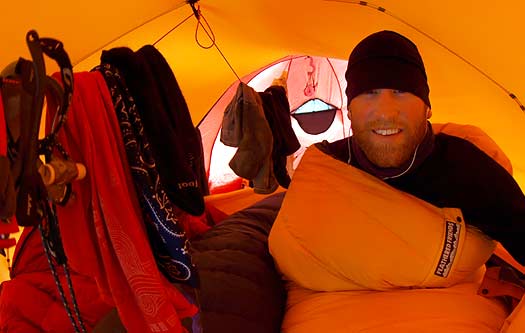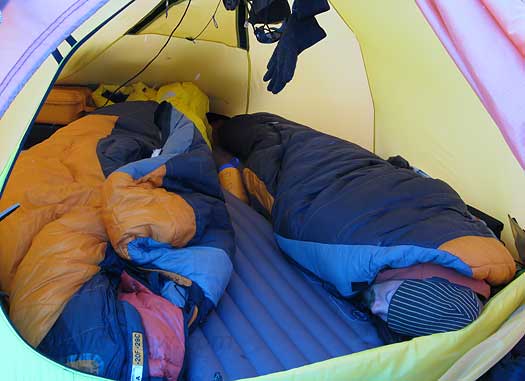While stranded here on Kahiltna Glacier like an icebound passenger ship, to break the boredom I’m getting going with more gear blogging. That’s good, because other more dangerous options exist. Outside my tent door the boys are building a terrain park, and the folks doing the Kahiltna Stare are still standing and gazing into the fog like patients in a mental institution. One can only assume they’ve gotten into their medical kits.
Today I got inspired to mention a few things about our tent gear.

Tyler with his Feathered Friends rental sleeping bag. Good choice, he says he slept in his skivvys even at 20 below zero. For exact model contact Feathered Friends and explain your needs.
As you all know by now from multiple blog posts, we’ve been very happy with our Hilleberg tents. Moving on from that, for ground insulation Louie and I got a 1/8 inch foam tent floor cover from Forty Below, and use Exped Downmat 7 Pump sleeping pads on top of that. The other fellows have similar combos, with or without the tent floor cover, using layers of foam pads and Thermarest inflatables.
The main thing with whatever pad system you pick is that you evaluate the weight vs other systems. For example, if you go with a tent floor cover, you don’t want to overdo it on the rest of your pad thickness and end up carrying more than you need. I sleep cold, and still found the Exped 7 to be plenty warm on top of our covered tent floor. Indeed, if I were to head up here again I think I’d try a slightly thinner and lighter inflatable, and still use the tent floor cover.
Regarding inflatables, the Exped Pump sleeping pad does have a built-in hand pump that works better than the first impression you get. Nonetheless, we highly recommend an airbag inflation system that doubles as a larger stuffsack — much less work.

Louie and Lou's tent in real life, Expeds and Fourty Below on the floor, Louie catching a snooze.
The beauty of the Forty Below floor cover is multi faceted. Mainly, once the sun hits your tent you end up quite a bit warmer (sometimes too warm) because you’re insulated from the ice block underneath. Another nice thing is that you don’t have the clammy condensation covered nylon that you have with a regular tent floor. You can throw gear around anywhere and it stays drier, and if you have electronic stuff the foam floor is a much better (drier and warmer) place for such things than setting them on a thin sheet of nylon over ice. The Fourty Below tent floor is white, which makes it much easier to find small items of gear in dim light than it would be on our black tent floor.
As for our Exped Downmat 7 pads. These things really are impressive and highly recommended, though again, if you sleep warm and use a tent floor cover, you should try something a bit more minimalist and see if it works so you’re not carrying extra weight. But if in doubt just bring something like the Exped.
A bit about sleeping bags. While I’m still a fan of synthetic, and can honestly say that some of the modern synthetics are nearly the same warmth as down per unit weight, it’s true that synthetics are more difficult to pack and in a warm/thick bag you do start to incur a noticeable weight penalty over down (at least when the down is fresh and dry, not after it’s absorbed moisture during sleeping).
It turns out that during a normal Denali expedition, you get enough solar heating in your tent to keep a down bag dry. That is unless you spend a lot of time camping high and receive more than your share of storms (and possibly end up in a snow cave or igloo). In that case, you might begin to see your down bag start to loose loft due to moisture retention and lack of drying time. That said, the vast majority of climbers up here do use modern down bags, sometimes with vapor barrier liners, and everyone seems to do ok.
So, what sleeping bags in particular? Louie and I are both using The North Face Climashield bags (Tundra model), mine with a down liner bag which I customized to tie in with a bunch of small sewn-in tabs. The Tundra bags are rated by North Face to 20 below zero F, but we found that to be optimistic. After a few 15 to 20 below zero nights up at 14,200 feet here on Denali, I’d give the Tundra more of a 10 degree above zero rating for my cold sleeping cuerpo, and a zero or 5 below rating for Louie, who sleeps warm. To remain comfortable at 15 below, we zipped our North Face Himalayan expedition parkas together into a quilt and threw that over us, which worked nicely.
As for the other guys, we’ve got a few sleeping in Marmot down bags, and a few in Feathered Friends models. Of any bag out there, it’s my feeling that the Feathered Friends over-deliver in warmth and performance, and getting set up with one for Denali would be a very good idea if you’re uncertain about what to bring. The company rents their sleeping bags, so that’s a good option if you don’t need to invest in a sub-zero down bag (the Feathered Friends bags we have on this trip are rentals, and they’re working fine).
Some sleeping bag tips: Many models have a complex system of Velcro and drawstrings to operate the hood, zipper closure and draft collar. I you tend not to use a draft collar, just cut the dang thing out or at least cut the velcro off. Otherwise, practice using this stuff at home. I don’t use a draft collar and found the collar velcro kept sticking to other stuff while I was sleeping, including my hat. Nothing like being half asleep and feeling your head stuck to your sleeping bag. After that fine experience, the draft collar velcro was removed with my swiss knife sissors and I’m now a much happier camper.
One advantage of synthetic bags is that if you tend to a dry throat after sleeping (I do), you can just throw the hood over your head and re-breath your warm moist air. Doing so with a down bag is not a good idea, as the down around your head will become quite saturated with moisture and be difficult to dry. With this in mind, if you tend to not use your sleeping bag hood in the conventional sense, consider covering any velcro hook you don’t use with a chunk of fuzzy velcro, that way you won’t have the danged stuff grabbing your hat all night, or even your socks as you exit the bag.
Sleeping bag ratings are always a laugh. You wonder, are they rated for what minimum temp you could survive in? Or are they rated for where you’ll sleep comfortable? And what about the incredibly wide range of folk’s metabolisms? My advice for Denali sleeping bag selection would be to first know your sleeping metabolism. Most outdoors people know if they sleep warm or cold compared to other folks, so just keep that in mind as you configure your system, and don’t get too optimistic. Your metabolism can only produce so much heat at high altitude, and sleeping warm and comfy is key to staying strong while doing any sort of alpinism.
I’m certain many of you winter camping vets out there have something to add or disagree with. Please comment and share your wisdom.
WildSnow.com publisher emeritus and founder Lou (Louis Dawson) has a 50+ years career in climbing, backcountry skiing and ski mountaineering. He was the first person in history to ski down all 54 Colorado 14,000-foot peaks, has authored numerous books about about backcountry skiing, and has skied from the summit of Denali in Alaska, North America’s highest mountain.

